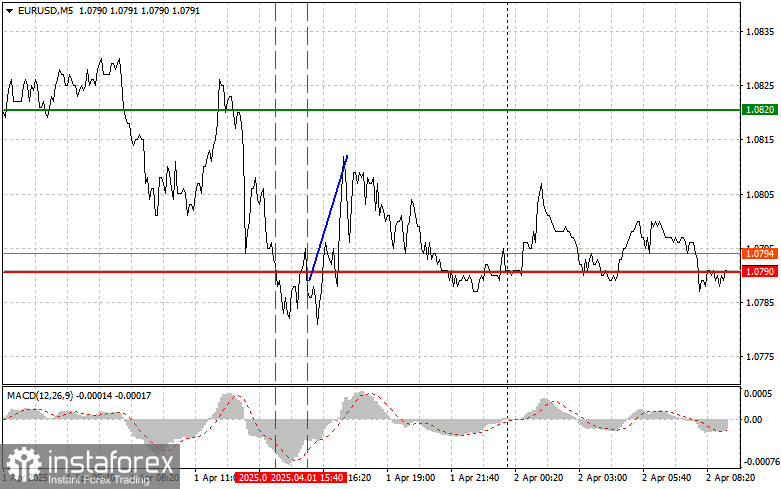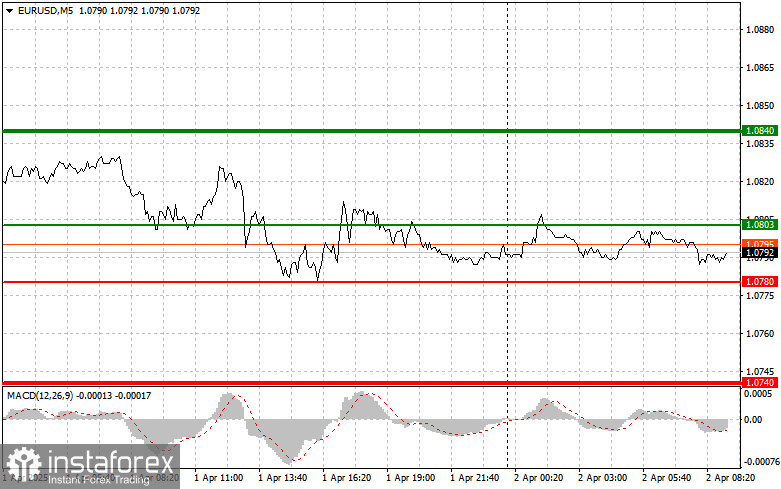Analysis of Trades and Trading Tips for the Euro
The price test at 1.0790 occurred when the MACD indicator had already moved significantly below the zero mark, which limited the pair's downside potential. For that reason, I did not sell the euro. A second test of 1.0790, with the MACD in the oversold zone, triggered Scenario #2 for buying the euro, which resulted in a 20-pip rise in the pair.
The euro did not react to yesterday's data on slowing inflation in the eurozone—neither rising nor falling—and remained within its current trading range. The published data showed that the core Consumer Price Index declined to 2.4% from 2.6%, outperforming analyst forecasts. Market participants chose to wait for further European Central Bank commentary on the matter to gain more clarity about the future of monetary policy.
No major macroeconomic releases are scheduled for the eurozone this morning, suggesting moderate trading activity. Investor attention will shift to the U.S. employment data and potential statements from Trump regarding tariffs, which could sharply increase pressure on risk assets, including the euro—so be prepared.
For intraday strategy, I will focus primarily on Scenarios #1 and #2.

Buy Signal
Scenario #1: I plan to buy the euro today at 1.0803 (green line on the chart), targeting a rise to 1.0840. At 1.0840, I plan to exit long positions and open short positions in the opposite direction, aiming for a 30–35 pip move from the entry. A bullish move in the euro in the first half of the day can only be expected as a minor correction. Important: Before buying, ensure that the MACD is above the zero line and beginning to rise.
Scenario #2: I will also consider buying the euro if there are two consecutive tests of 1.0780, with the MACD in oversold territory. This would limit the pair's downside potential and likely trigger a bullish reversal. Expect a rise toward 1.0803 and 1.0840.
Sell Signal
Scenario #1: I plan to sell the euro after it reaches 1.0780 (red line on the chart), targeting a drop to 1.0740, where I will close short positions and enter long positions (expecting a 20–25 pip rebound). Pressure on the pair may return if there are unexpected tariff-related developments. Important: Before selling, ensure that the MACD is below the zero line and starting to decline.
Scenario #2: I will also consider selling the euro after two consecutive tests of 1.0803, provided the MACD is in the overbought zone. This would limit the pair's upside potential and trigger a bearish reversal. Expect a decline toward 1.0780 and 1.0740.

What's on the Chart:
- The thin green line represents the entry price where the trading instrument can be bought.
- The thick green line indicates the expected price level where a Take Profit order can be placed, or profits can be manually secured, as further price growth above this level is unlikely.
- The thin red line represents the entry price where the trading instrument can be sold.
- The thick red line indicates the expected price level where a Take Profit order can be placed, or profits can be manually secured, as further price decline below this level is unlikely.
- The MACD indicator should be used to assess overbought and oversold zones when entering the market.
Important Notes:
- Beginner Forex traders should exercise extreme caution when making market entry decisions. It is advisable to stay out of the market before the release of important fundamental reports to avoid exposure to sharp price fluctuations. If you choose to trade during news releases, always use stop-loss orders to minimize potential losses. Trading without stop-loss orders can quickly wipe out your entire deposit, especially if you neglect money management principles and trade with high volumes.
- Remember, successful trading requires a well-defined trading plan, similar to the one outlined above. Making impulsive trading decisions based on the current market situation is a losing strategy for intraday traders.





















